Our Values Rise and Fall Depending on the Issue
Part V of a series March 23, 2025
Our appetite for many of our most important values expands and contracts with the issue at hand.
They look good, feel good, when considered on their own. Their standing is confirmed by the high marks they gained, agreed upon across party lines, in the polling done by Our Common Purpose as part of its study of American values, what about them unites and divides us, and what we might do about it.
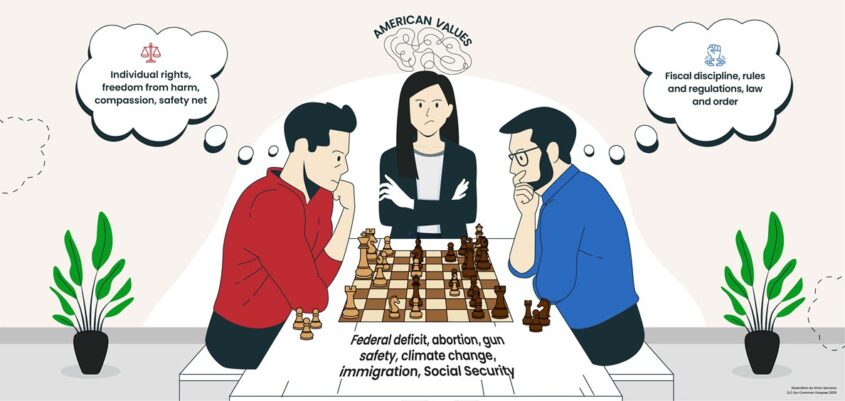 But rarely in real life does one value come into play independent of any others. The central tenet of values pluralism, the theoretical framework on which this study is based, suggests that our values inevitably smash into one another as we try to resolve major issues. We must choose. How much we want of one value and correspondingly how much of the other we’re willing to sacrifice.
But rarely in real life does one value come into play independent of any others. The central tenet of values pluralism, the theoretical framework on which this study is based, suggests that our values inevitably smash into one another as we try to resolve major issues. We must choose. How much we want of one value and correspondingly how much of the other we’re willing to sacrifice.
The progenitor of values pluralism, Isaiah Berlin, states it more eloquently: “Some of the Great Goods cannot live together. That is a conceptual truth. We are doomed to choose, and every choice may entail an irreparable loss.”
Berlin himself was fascinated by the various connotations of liberty. Many years later, the variation on this theme that arose in Our Common Purpose’s work is the profound distinction between our freedom to act and our expectation of freedom from harm.
The latter of the two, freedom from harm, turns out to be a consistent favorite in the nationwide public opinion poll focusing on 25 key American values done in September. The survey furnishes numerical evidence for what otherwise has been theory. The 2,500 respondents, who mirror the characteristics of the nationwide voting population, were asked by Survey USA to answer a lengthy set of questions using a sliding scale of -100 to +100.
Freedom from harm is among the very few exceptions to the general rule stated in the opening paragraph, proving to be impervious in several head-to-head contests with other values. While there are not enough data points to be sure about this, freedom from harm could well be America’s dominant value.
Otherwise, however, Our Common Purpose has found that the strength of many of our values ebbs and flows based on the issue at hand. One of the best examples is the contest between rules and regulations and individual rights. Both are among what are coined in this study as Shared Values, meaning they score high in importance with high agreement across party lines. (Please note in the chart below that the values on the horizontal axis of Individual Rights have been reversed to make it visually comparable with the charts that follow.)
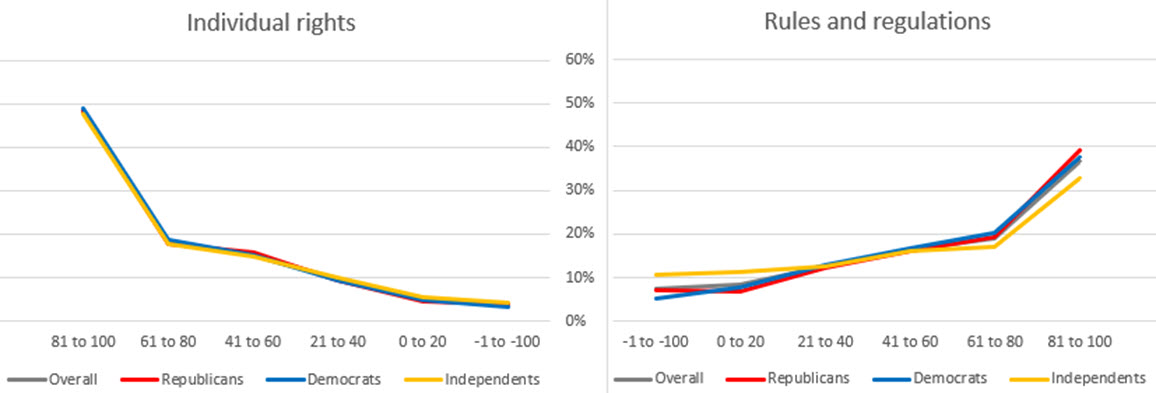
That’s when the values are considered in isolation. But the acid test comes when they are put up against each other. Entirely in keeping with the general proposition put forward by Berlin, our values inevitably come into conflict with each other. Our Common Purpose’s survey shows that our backing of them is not irrevocable. It’s situational, depending very much on the issue at hand. This isn’t necessarily a bad thing. Rather than stubbornly sticking to one value or the other, many are able to judge the trade-offs and adjust accordingly.
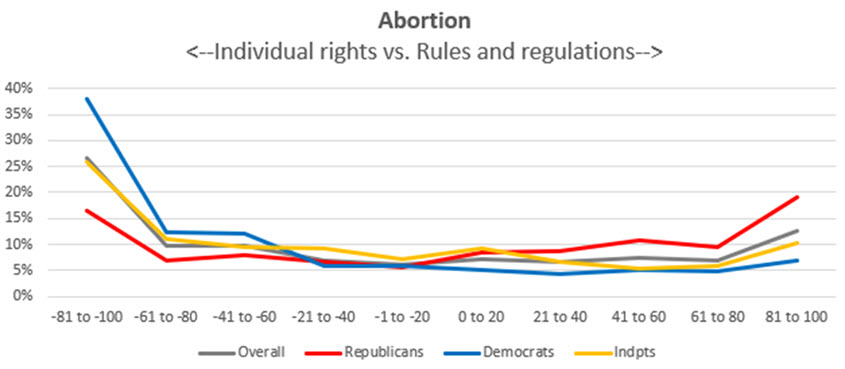
On abortion, the standoff tilts to the side of individual rights. A woman’s right to choose, a woman’s control over her own body, all that. Democrats, with independents not too far behind, lean in that direction, although not exclusively. Republicans are almost evenly split, with nearly as many strongly favoring individual rights as rules and regulations.
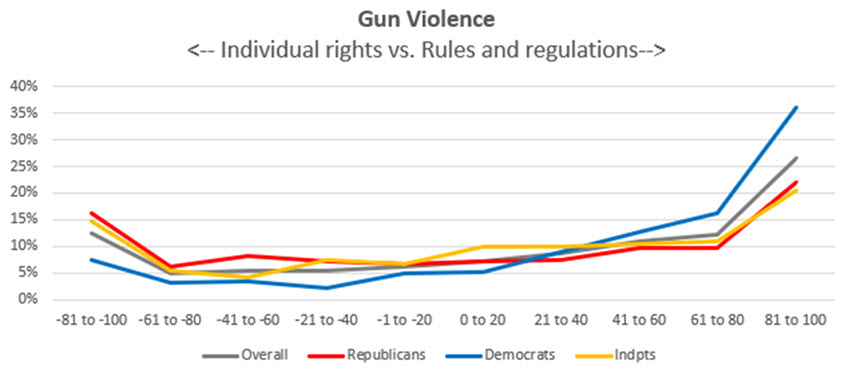
The script flips on gun violence, with rules and regulations gaining the upper hand. Democrats, averse to rules and regulations on abortion, are no surprise all-in on regulating guns. There’s a segment that sticks with individual rights – in this case, meaning the 2nd Amendment – but even among Republicans, more come down on the side of rules and regulations.
The nod on climate change also comes down on the side of rules and regulations. Here the competing value is not individual rights but rather the freedom to act. No matter, rules and regulations prevails across political persuasions. Republicans are the most likely to swing in the other direction but even they favor rules and regulations by a pretty wide margin.
On another front, the hatchet that Elon Musk and DOGE are taking to federal government is giving whole new meaning to fiscal discipline. But here again, support ebbs and flows depending on what’s being targeted.
Perhaps foreshadowing the elimination of USAID, the survey shows fiscal discipline gets the nod over global leadership. Republicans and independents tilt in that direction, with Democrats on the fence.
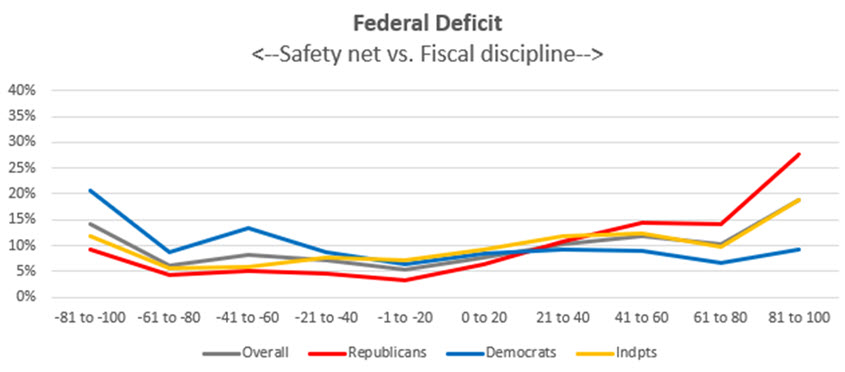
The safety net fares slightly better in its contest with fiscal discipline, achieving close to a standoff. When the question turns specifically to Social Security, fiscal discipline slips a bit more. The near parity for both the safety net in general and Social Security in particular is due more to Democrats than Republicans.
While the safety net barely hangs on, the Defense Department should have nothing to worry about. In near equal numbers, Republicans, Democrats and independents choose national security over fiscal discipline. Any further large budget cuts will have to come from somewhere else.
The strength of our fiscal discipline, deemed a Subordinate Value in the Our Common Purpose scheme of things, rises and falls depending on what’s on the chopping block.
True to Isaiah Berlin’s “conceptual truth,” our values inevitably come into conflict with each other. But the growing tendency to address these conflicts by resorting to all-or-nothing measures, alarmingly caricatured by Elon Musk and his chainsaw, doesn’t have to be this way.
Next: Four constructs for dealing with conflicts
Part I: Our Key Values Both Unite and Divide
Part II: Some Values Get More Regard than Others
Part III: How 25 American Values Stack Up
